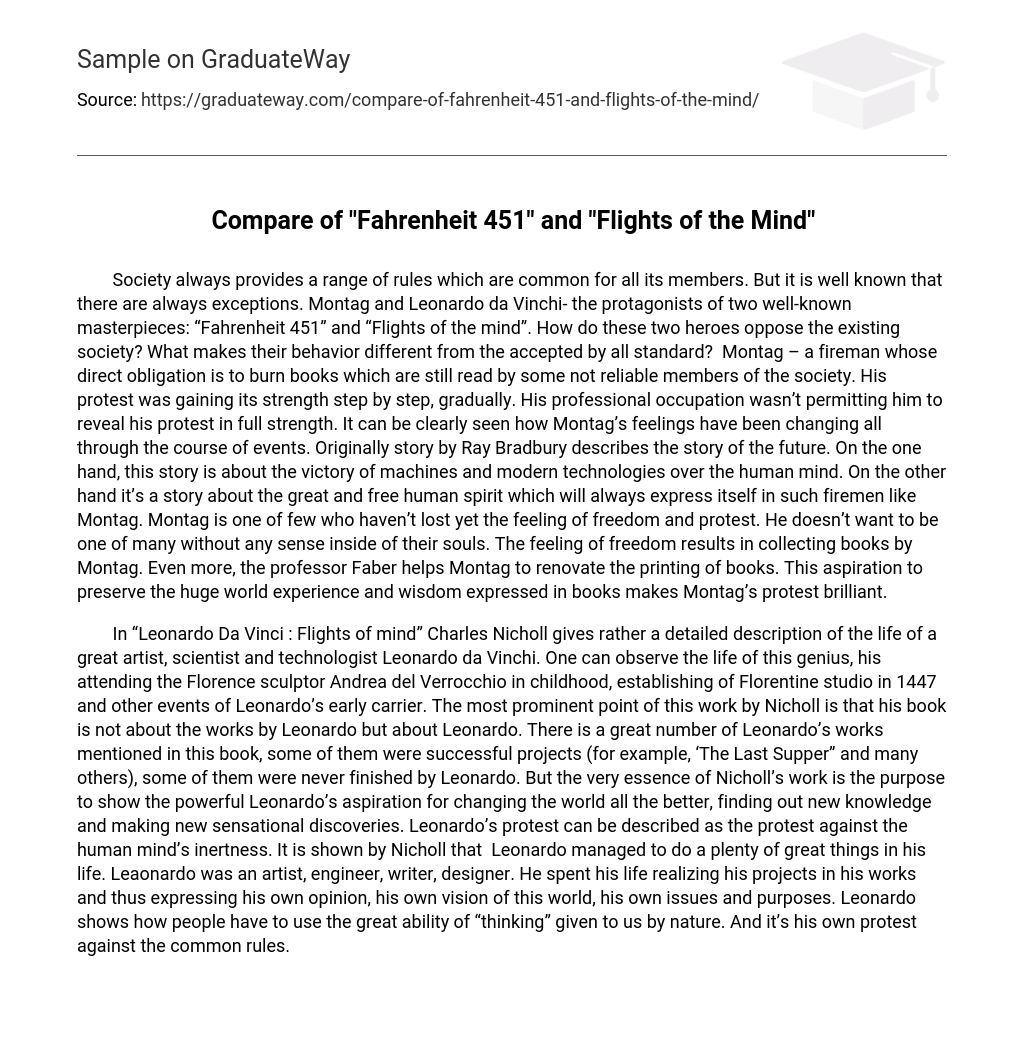Society always provides a range of rules that are common to all its members. However, it is well-known that there are always exceptions. Montag and Leonardo da Vinci are the protagonists of two well-known masterpieces: Fahrenheit 451″ and “Flights of the Mind”. How do these two heroes oppose existing society? What makes their behavior different from the standard accepted by all?
Montag is a fireman whose direct obligation is to burn books still read by some unreliable members of society. His protest gained strength gradually, as his professional occupation didn’t permit him to reveal his protest in full strength. It can be clearly seen how Montag’s feelings changed throughout the course of events.
The original story by Ray Bradbury describes a future where machines and modern technologies triumph over human minds. On the other hand, it’s also a story about great and free human spirit which will always express itself in such firemen like Montag.
Montag is one of few who haven’t lost yet their feeling for freedom and protest. He doesn’t want to be one among many without any sense inside their souls. The feeling of freedom results in collecting books by Montag, even more so with Professor Faber helping him renovate book printing.
This aspiration to preserve huge world experience and wisdom expressed in books makes Montag’s protest brilliant.
In “Leonardo Da Vinci: Flights of Mind,” Charles Nicholl provides a detailed description of the life of the great artist, scientist, and technologist Leonardo da Vinci. The book covers various events in Leonardo’s early career, such as his childhood attendance at Florence sculptor Andrea del Verrocchio’s studio and the establishment of his Florentine studio in 1447. Nicholl’s work is not about Leonardo’s works but rather about Leonardo himself. Though many of Leonardo’s works are mentioned in this book, some successful projects like “The Last Supper” and others were never finished by him.
The essence of Nicholl’s work is to show how powerful Leonardo was in his aspiration to change the world for the better by finding new knowledge and making sensational discoveries. His protest can be described as a rebellion against human mind inertness. Nicholl shows that despite facing numerous challenges, Leonardo managed to accomplish many great things throughout his life. He was an artist, engineer, writer, and designer who spent his life realizing projects that expressed his own opinions on this world.
Leonardo demonstrates how people should use their innate ability to think critically given to us by nature; it is a protest against common rules.
Comparing the protests of Leonardo da Vinci and Montag, it is necessary to note that their protests are different. Montag stands up against society in a more silent way than Leonardo da Vinci. Montag’s protest is that of an ordinary member of society who dislikes the environment in this society. He does not have enough power to change the course of events, but he does his best to change the situation, and that is why his protest is valuable. It is difficult to say whose protest is more dangerous and effective. Montag stands up against the social system in which he lives while Leonardo stands up against the greatest minds of his time. The protest by Leonardo – a genius – may be louder, but it cannot be said whether it’s more or less efficient than Montag’s one. Both protests by Leonardo and Montag are great, efficient, and of enormous value for humanity.
The only difference between them lies in their professions; while Leonardo da Vinci was an artist whose protests have remained for centuries through his beautiful works, Montag was a fireman who did not create any pictures. However, his protest is no less powerful than that of da Vinci’s because both served as magnificent phenomena for human mind and freedom of human spirit.
Precisely thanks to such heroes (in full notion of this word), a huge treasure trove of human experience and wisdom remains alive today.
In conclusion, it must be said that the protagonists of Fahrenheit 451″ and “Leonardo da Vinci – Flights of the Mind” by Charles Nicholl are different and original. However, they should always be investigated from the same point of view as they represent the unique and eternal human purpose to realize the unlimited skills of the human mind to their fullest potential.
Bibliography
1. Charles Nicholl’s Leonardo Da Vinci: The Flights of the Mind” was published in 2005 by Penguin Books Ltd.
2. Ray Bradbury, 1987, Fahrenheit 451, Del Rey; Reissue edition





